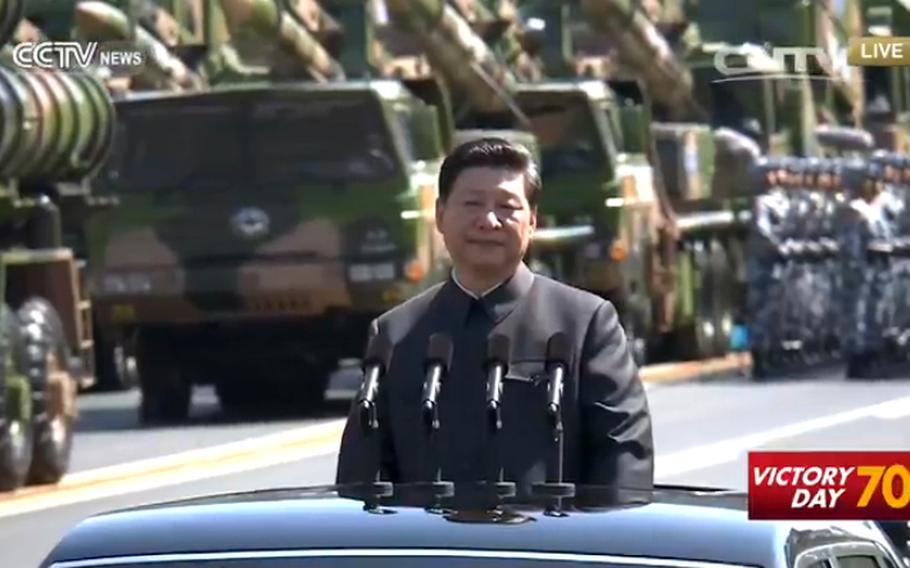
President Xi Jinping speaks Thursday, Sept. 3, 2015, during a massive parade in Beijing commemorating the 70th anniversary of the end of World War II. (Screen capture from Chinese state broadcaster CCTV)
China used a parade marking the 70th anniversary of Japan’s World War II defeat to try to persuade the world of its peaceful intentions by announcing a major cut in military staffing — while also displaying some of its most advanced long-range missiles and military hardware.
The show of strength — the parade reportedly featured more than 12,000 troops and 500 pieces of military hardware, including the first public appearance of a missile designed to attack aircraft carriers — may be the message that is most likely to sink in among China’s neighbors.
They say Beijing’s rapid military modernization and assertive moves on territory claimed by several other nations have increased tensions throughout the region.
Chinese ships and aircraft have been involved in low-level standoffs with Japanese ships in the East China Sea, and with the Philippines and Vietnam in the South China Sea in recent years. During the past year, China built artificial islands on top of disputed reefs, augmenting them with runways and harbors.
Chinese President Xi Jinping tried to allay concerns about China’s intentions Thursday with the announcement that the military would cut 300,000 personnel from its ranks.
“We Chinese love peace,” Xi said during the parade’s opening remarks. “No matter how much stronger it may become, China will never seek hegemony or expansion.”
Xi did not elaborate on where the cuts would come.
However, recent reports have speculated that China is preparing to consolidate its army, navy, air force, missile commands and other units into a more unified, joint command structure similar to that of the United States.
China’s active-duty military totaled 2.3 million in 2013, according to The Military Balance, an annual survey of the world’s forces. Total military personnel numbered 3 million, including paramilitary and supporting agencies, according to World Bank figures. Chinese defense spending now ranks second only behind the U.S.
The People’s Liberation Army cuts would be the fourth restructuring since 1985, according to Andrew Erickson, an associate professor and co-founder of the U.S. Naval War College’s China Maritime Studies Institute.
The 70th anniversary parade began with live shots on China’s CCTV television of Xi and other Chinese dignitaries standing through the sunroofs of their limousines as they made their way toward the stands at Tiananmen Square, the site of China’s 1989 crackdown on pro-democracy demonstrators.
The parade commenced with a large display of military hardware, highlighted by the first public appearance of the DF-21D missile, dubbed by some as the “carrier killer.” The anti-ship missile is reportedly capable of changing direction in flight and striking carrier groups from long-range, land-based mobile launchers, though that capability hasn’t been publicly demonstrated.
The United States regularly patrols the Asia-Pacific with aircraft carriers, including in waters China ambiguously claims as its own, but that the U.S. and most of China’s neighbors consider international territory.
The DF-21D missile has been addressed in Pentagon reports on China extensively since U.S. intelligence reports stated that it had reached initial operating capability in 2009.
David Garretson, a retired professor of international relations for the University of Maryland University College in Seoul, said China was expected to display new military equipment during the parade “to show that they are a comer on the international scene.”
“The party is using nationalism as a unifying force to replace the dimming ideology of communism,” he said.
China’s parade was generally heavy on missile displays, including its intercontinental ballistic missiles and others capable of nuclear, conventional and shipborne attacks. Its land-based and carrier-based fighter jets also conducted flybys, with action cameras installed in the cockpits broadcasting close-ups to viewers in China and online.
“China’s V-Day military parade today has two major audiences: domestic and foreign,” Erickson wrote in an online post. “With regard to the foreign audience, I believe that an important part of its purpose is to reveal enough about Chinese capabilities to enhance deterrence and persuade potential adversaries to — at a minimum — treat Beijing’s concerns with the utmost care.”
Russian President Vladimir Putin, South Korean President Park Geun-Hye and dignitaries from several other countries were on hand. The heads of state from Japan and most Western countries declined invitations, though several sent lower-level officials.
For Park, attending the parade was a strategic move aimed at improving Seoul’s relations with China and ultimately increasing its influence throughout the region.
Garretson said Park, who speaks Mandarin, believes the South can act as a bridge between the U.S. and China. She also wants to revive relations between Tokyo, Beijing and Seoul as a way to increase pressure on North Korea.
She hopes her presence will encourage China to leverage its influence over Pyongyang, particularly after a recent sharp escalation of tensions on the Korean peninsula. Three days of inter-Korean talks eased the situation, but many analysts believe the North could be preparing for missile launches or some other provocation.
The parade received a cool response from officials in Japan. Japanese administrations have expressed remorse for Japan’s colonization of China in the 1930s, but historical grievances remain alive in China.
While Japan typically refers to the conflict with terms equivalent to the “China-Japan War,” China labels it the “War of Chinese People’s Resistance Against Japanese Aggression.”
“We have asked China to work on common challenges that the international society faces today in a future-oriented stance, instead of overly focusing, unfortunately, on past history,” Japan Chief Cabinet Secretary Yoshihide Suga told a news conference Thursday morning.
Stars and Stripes reporter Ashley Rowland contributed to this report.
This story will be updated.
slavin.erik@stripes.com Twitter: @eslavin_stripes